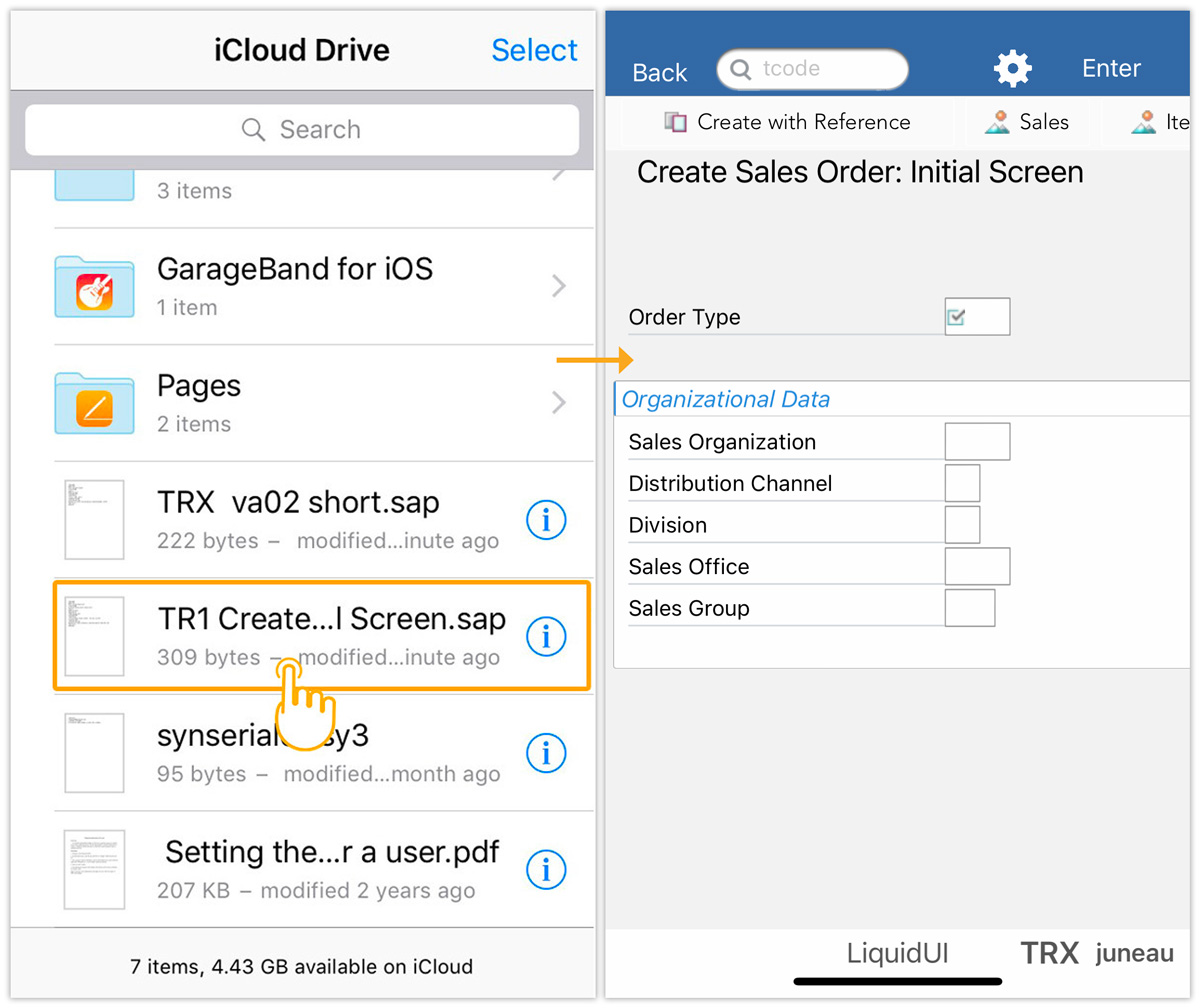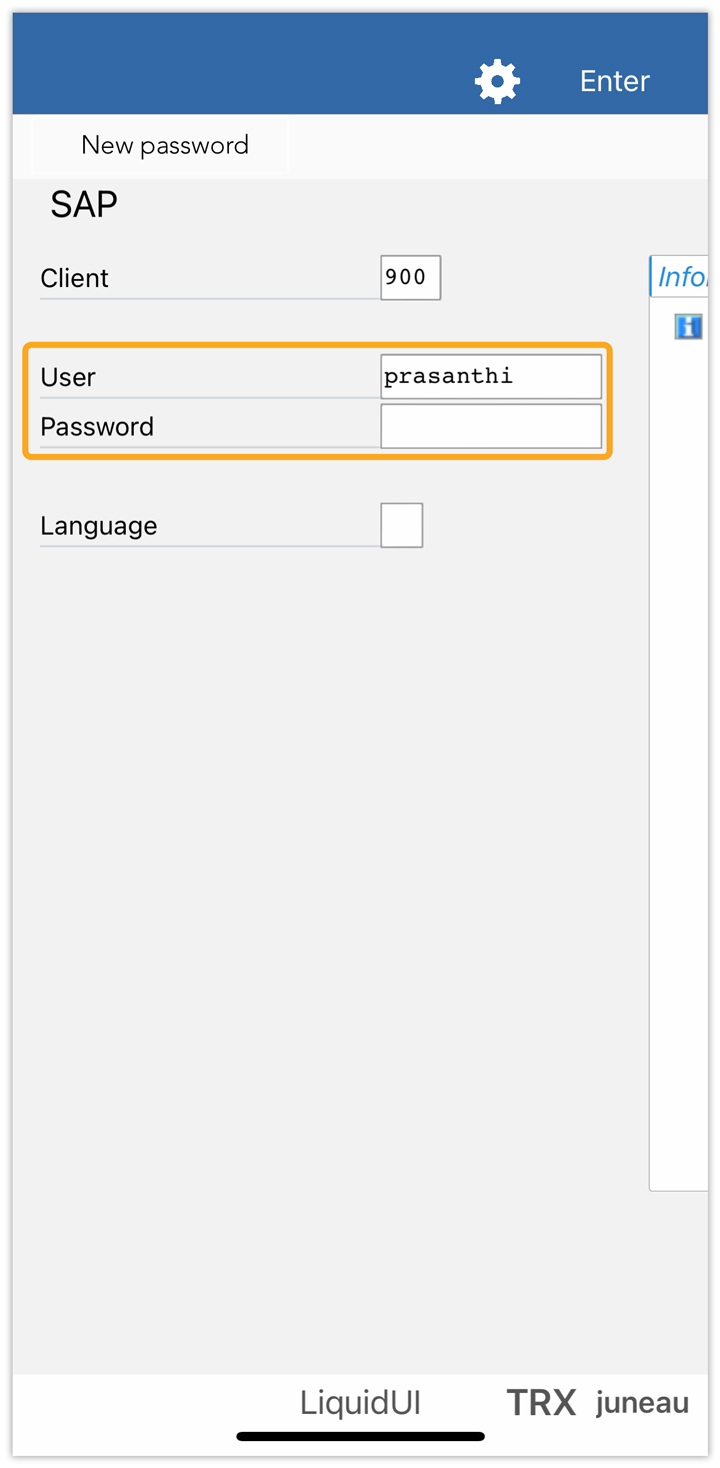Purpose
With Liquid UI RPA for SAP, you can automate various SAP-related tasks, such as logging into SAP, navigating to specific transaction screens, creating master data, executing reports, and determining subsequent actions based on predefined logic. Automating transactions within your SAP ERP system streamlines slow, manual, error-prone tasks, reducing the need for user intervention. This results in substantial cost and time savings.
Liquid UI for iOS supports two types of SAP automation.
Automation via URL
With a single click on a URL, you can directly navigate to the required transaction or process, such as creating a Sales Order or Material. This SAP automation process eliminates the need for manual entry of transactional details, thereby boosting productivity by saving time and reducing the potential for errors from data re-entry.
Automation through a URL opens the Liquid UI app and automatically transfers necessary information, including SAP connection details, login credentials, commands, and field values, to execute the predefined SAP process. Depending on your SAP process requirements, you can customize the transaction code, field values, and other parameters in the URL.
Example
In this scenario, we’ll demonstrate how to navigate to the Display Sales Order screen automatically with a URL on your iOS device.
Below is the URL format that can be opened in a web browser on your iOS device.
- Open the below URL link in a web browser on your Liquid UI for iOS devices. You can use the following URL parameters described while creating an automated URL.
URL parameters are as follows.URL Parameters Liquid UI Connection Parameters sapr3:// Instruct the browser to open the URL through the Liquid UI app //r3/target?gui Specify the target server you want to connect with /H/Servername Application Server Configuration /M/Servername Message Server Configuration /S/3224 Sapproxy Port Configuration 24 System Number, which is drawn from the last two digits of the proxy port number Client 800 - Liquid UI Client number User SAP username Password SAP password Language EN - English Command It can be a transaction, report, or system command - Displays a popup message to open the URL link with the Liquid UI app. Clicking Open will navigate to the specified SAP transaction, Display Sales Order: Initial Screen.
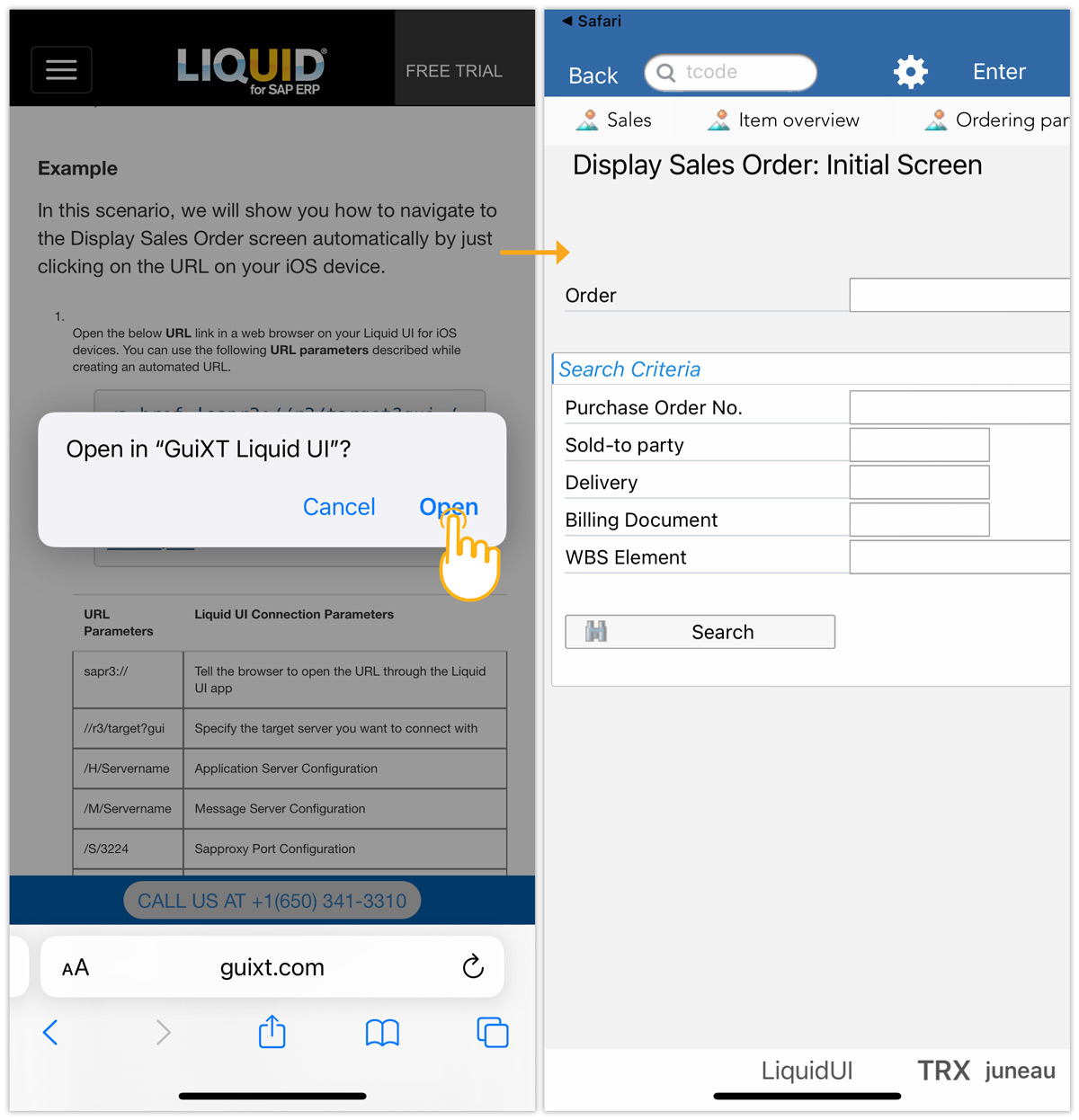
- Input the Order number and tap Enter will execute the SAP process specified in the URL.
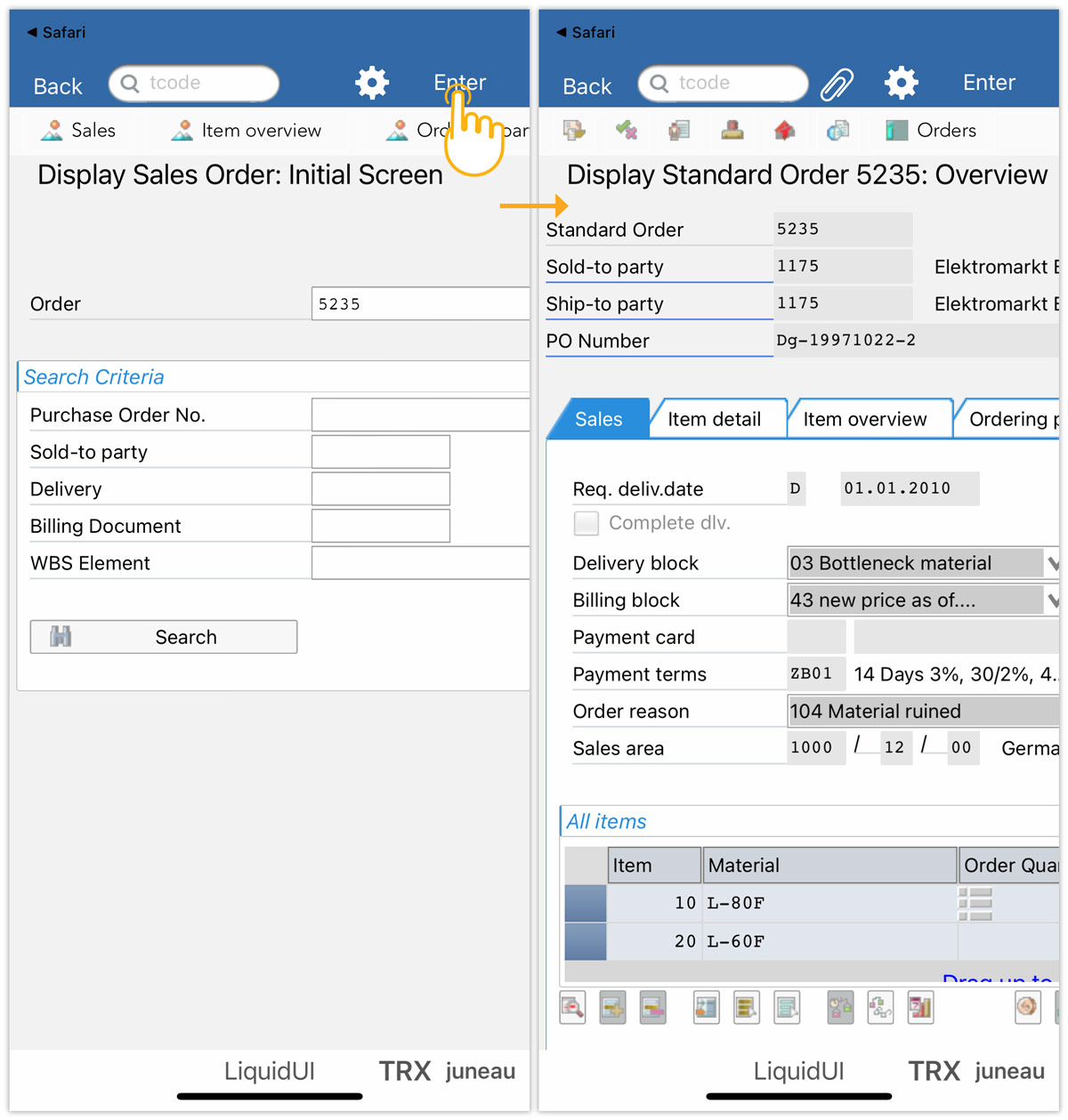

Note: The Liquid UI app will only get connected to the SAP if the connection parameters in the URL match with the connection list in the Liquid UI app.
- If Autologon is turned off or the URL contains incorrect login credentials, the logon screen is displayed before proceeding with the predefined SAP process.
URL EXAMPLES
Message Server:
<a href='sapr3://r3/target?gui=/M/SAPAPPSERVER/S/3600/G/SPACE&client=800&user=luiuser&password=luipassword&language=EN&command=VA03;VBAK-AUART=AE;>Connect to SAP Message Server</a>
Application Server:
<a href='sapr3://r3/target?gui=/H/SAPAPPSERVER/S/3200&client=800&user=luiuser&password=luipassword&language=EN&command=VA03;VBAK-VBELN=5235;RV45S-KUNNR=1460;enter'>Connect to SAP Application Server</a>
Automation via .sap file:
Utilizing SAP shortcut files streamlines navigation to specific transactions or execution of SAP processes. For instance, these files eliminate the repetitive task of entering SAP details and navigating menus to access the same transaction screen.
To generate an SAP shortcut file, simply input the SAP Server Connection details, login credentials, and the relevant transaction code or command into your SAP GUI. This process allows you to create as many shortcut files as necessary and can be accomplished in two ways using the SAP GUI.
- Creating an SAP shortcut file from Desktop
- Creating an SAP shortcut file from a specific SAP transaction screen
Creating an SAP shortcut file from Desktop
In this scenario, we’ll demonstrate navigating to the VA01 transaction, automatically without any manual entry. Follow the steps below.
- Right-click on the desktop and choose New→SAP GUI Shortcut.
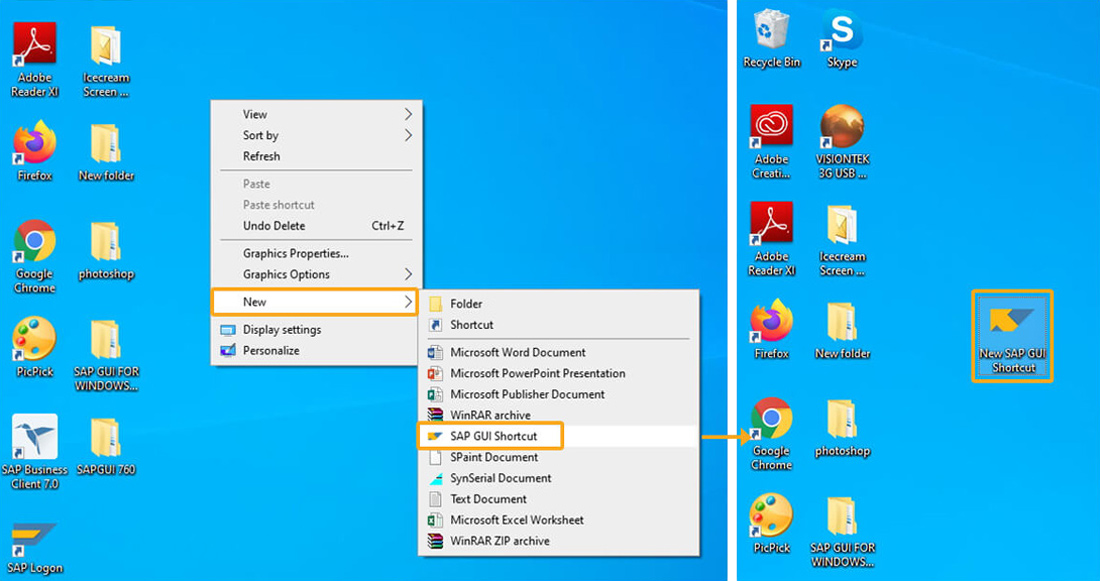
- Click on the New SAP GUI Shortcut to rename it.

- To define the .sap shortcut file, place the cursor on the shortcut icon, and do a right-click. Select Edit from the context menu to open the SAP Shortcut Properties window.
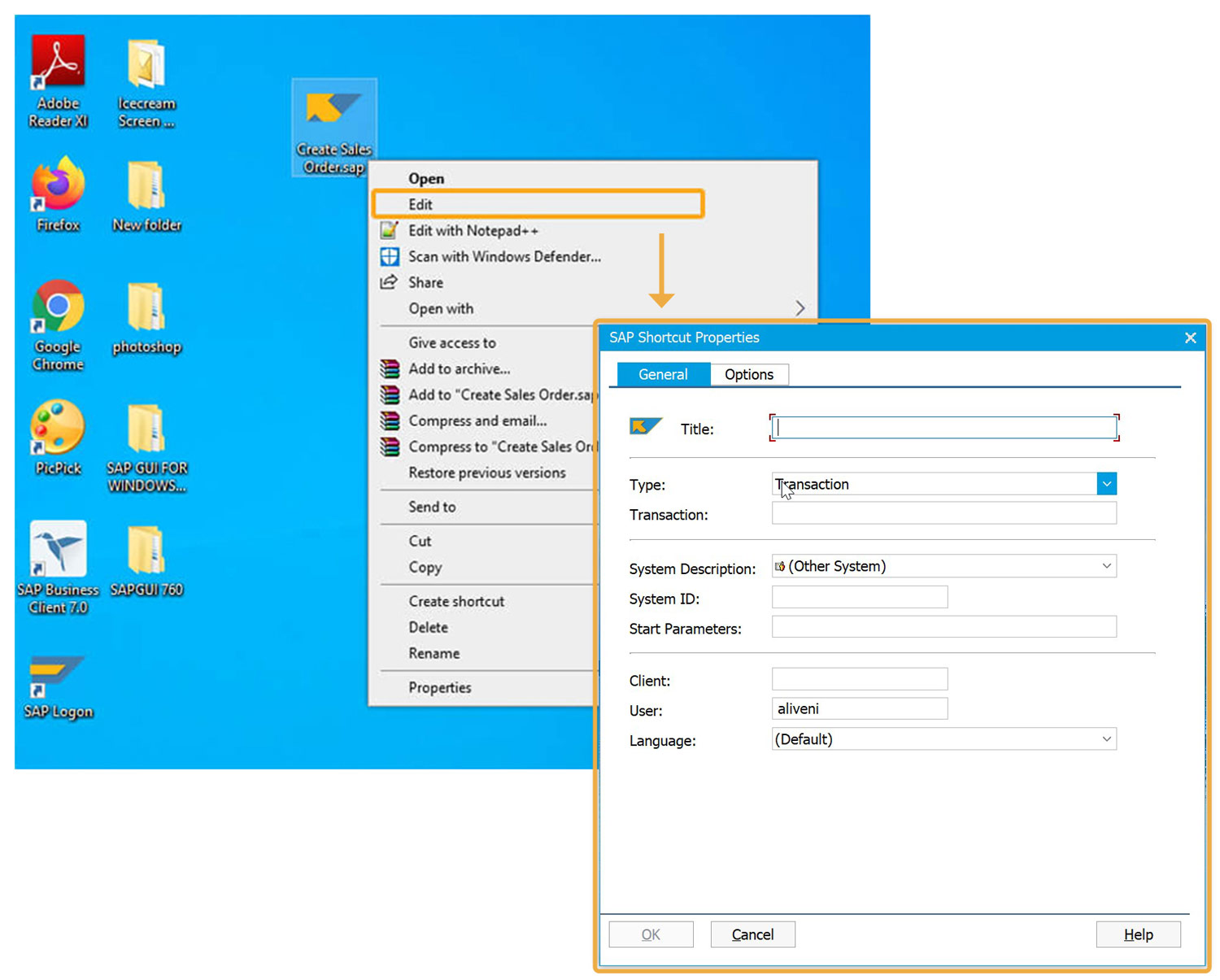 The SAP Shortcut file property window has the following details:
The SAP Shortcut file property window has the following details:Title Enter the shortcut title Type Specify the type of transaction. The type can be a transaction, report, or system command Transaction/Command/report Enter the appropriate transaction, report, or system command System Description Enter the name of your desired SAP system. You can even select from the drop-down list System ID Enter the system id of the SAP system Start Parameters Enter the SAP GUI parameters Client Enter your SAP client number User Enter your user name. By default, it takes the windows username Password If the field is enabled, you can specify a password. By default, it is deactivated for security reasons. Language Select your preferred language. - Fill in the details and click OK. You can observe .sap shortcut file Create Sales Order is created on the desktop.
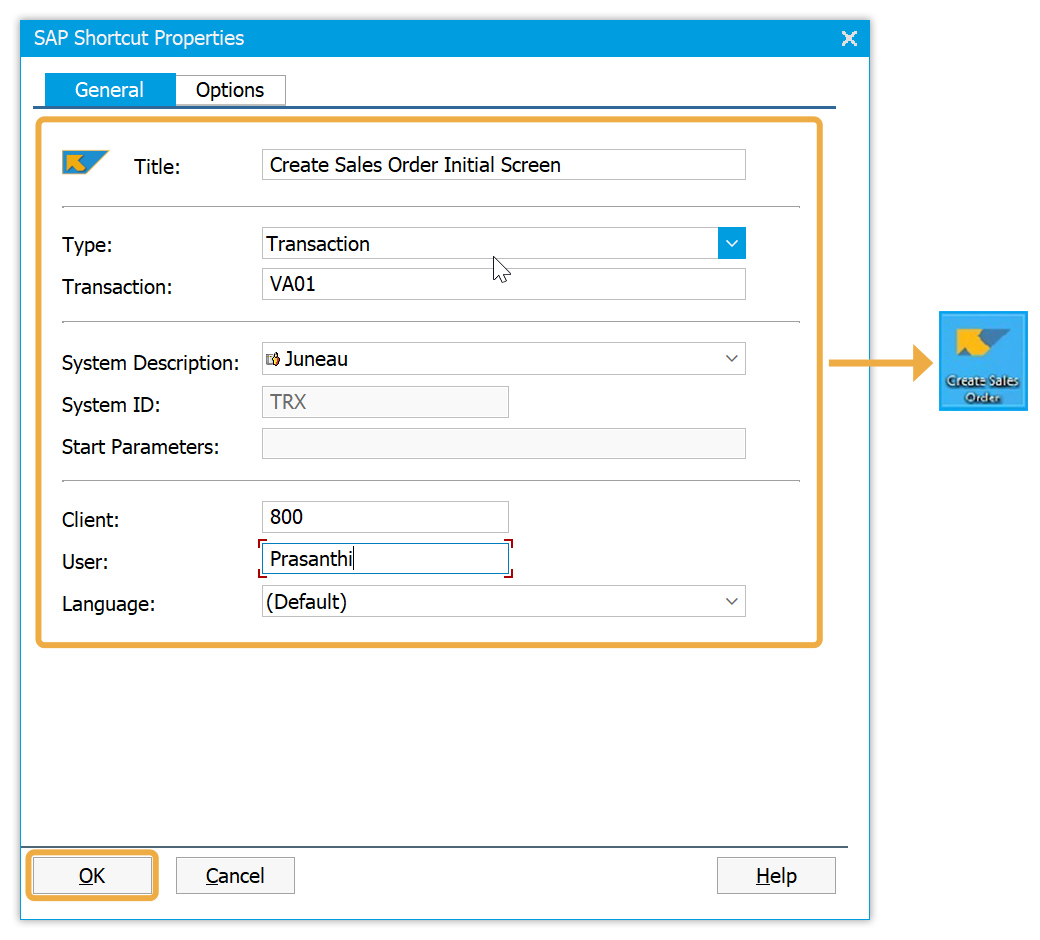
- Double-click the .sap shortcut icon to navigate to the VA01 transaction in SAP.
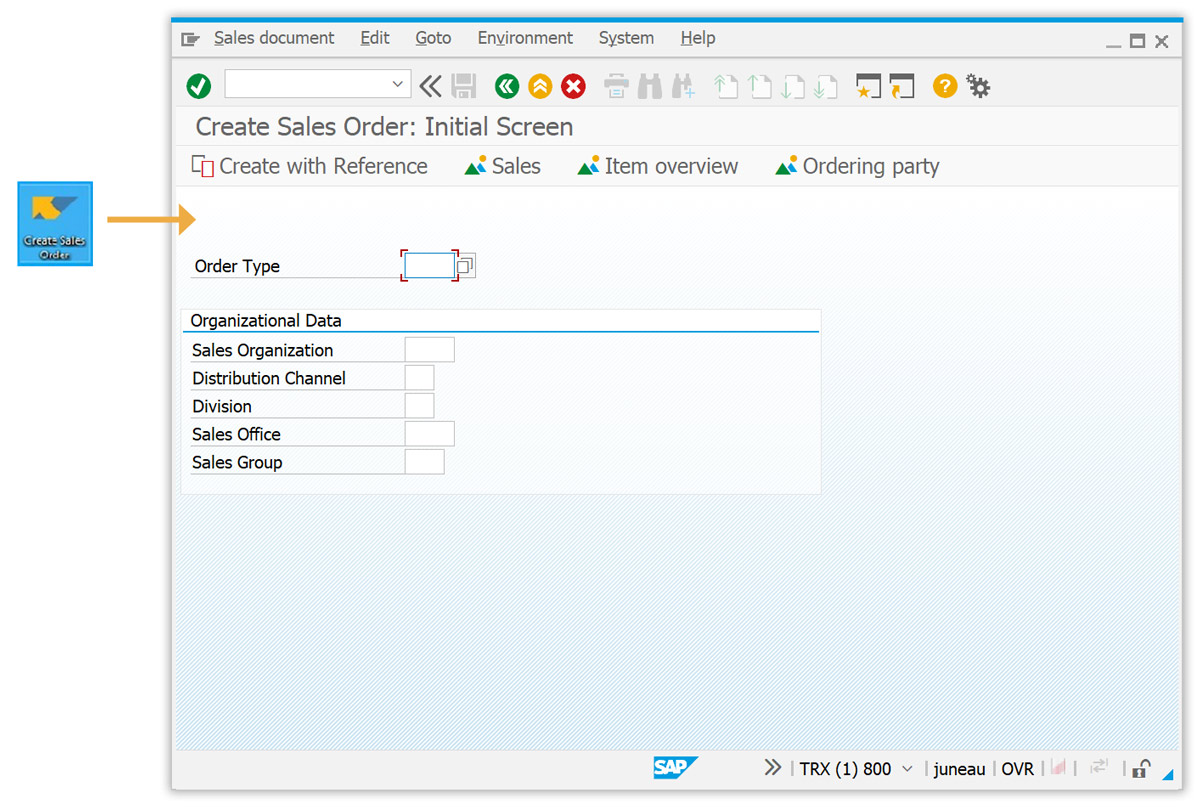

Note: Ensure your SAP login credentials are added to your .sap file to navigate the required transactions automatically.
- When running a *.sap file, if you cannot log in to SAP, you will be prompted to enter your SAP login credentials, as shown below.
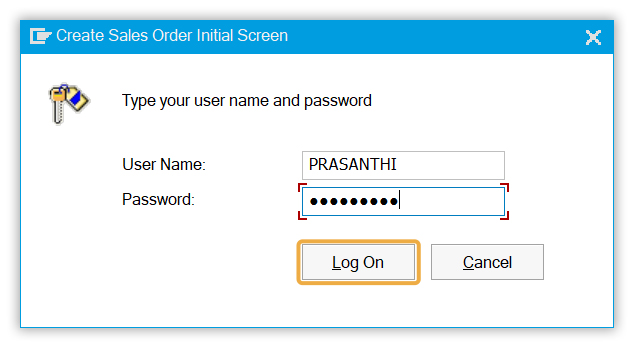
- Creating a .sap file allows for easy navigation to any transaction with just a single click.
Creating an SAP shortcut from a specific SAP transaction
Following these steps, you can make a quick way to access a predefined SAP task. We'll use the VA01 screen as an example.
- On the VA01 screen, click the Generate a shortcut icon in the menu bar. This displays the Create New SAP Shortcut window. You can edit the title and SAP server connection details as required and click Finish to complete the creation of the new shortcut file.
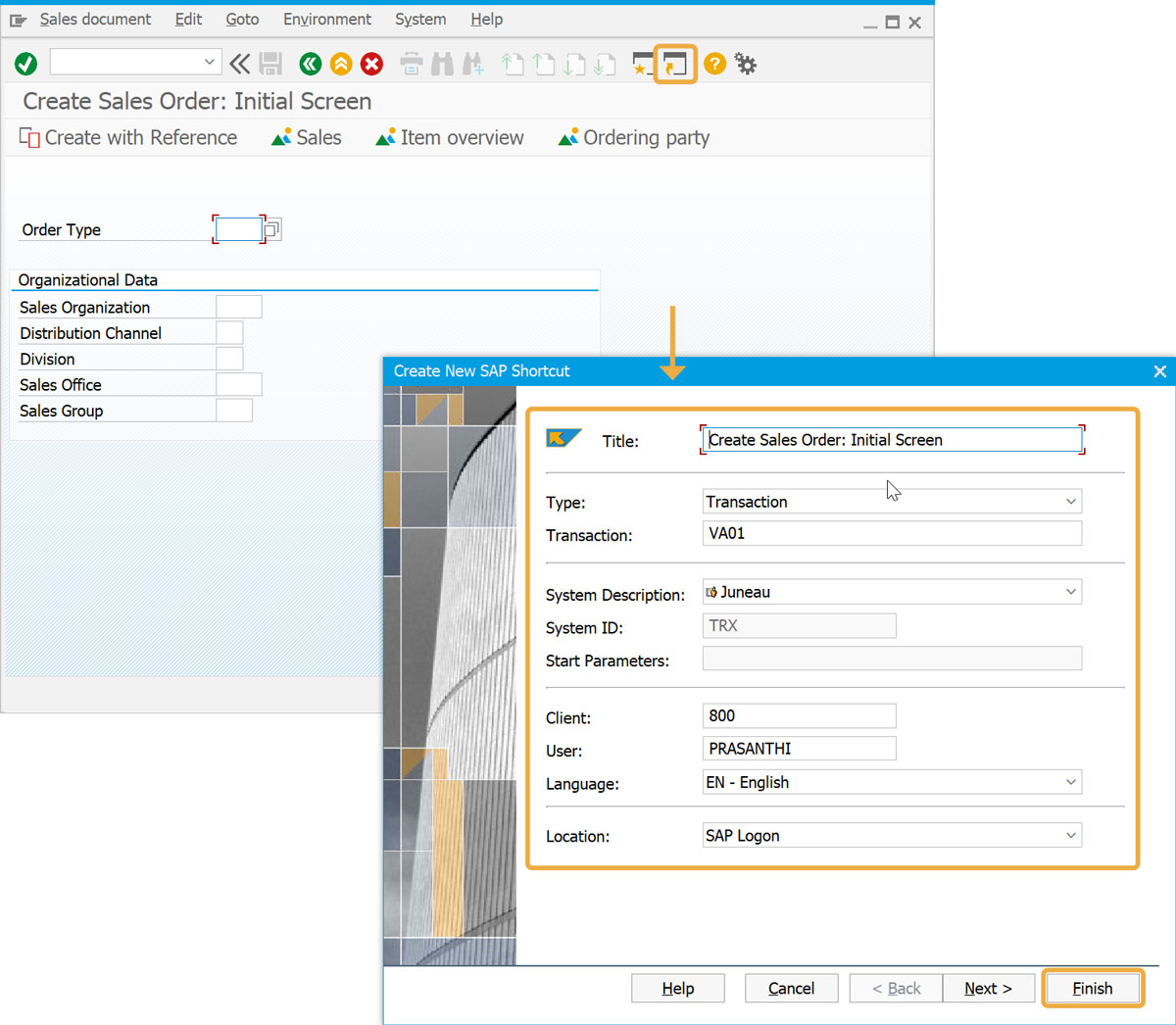
- You can observe that a new shortcut file icon is created on both the SAP Logon screen and your Desktop, as shown below.
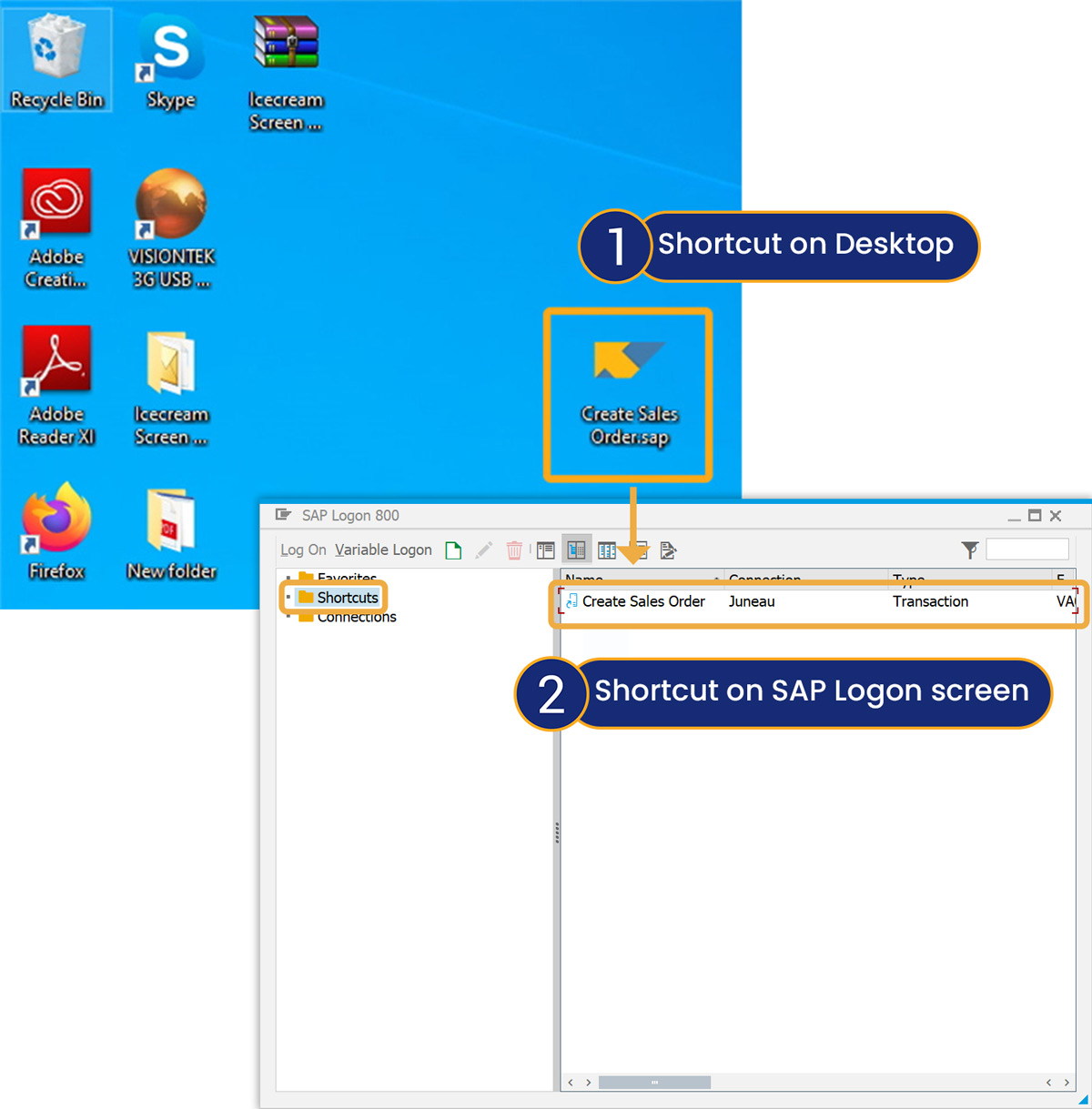
Launch a connection through the SAP shortcut file on iOS
In this scenario, we’ll showcase how to edit an SAP shortcut file, create SAP shortcut files in three different ways, and launch a connection on an iOS device using an SAP shortcut file.
- On the desktop, right-click the Create Sales Order .sap shortcut file and select Edit with Notepad++ to edit the shortcut file details in Notepad.
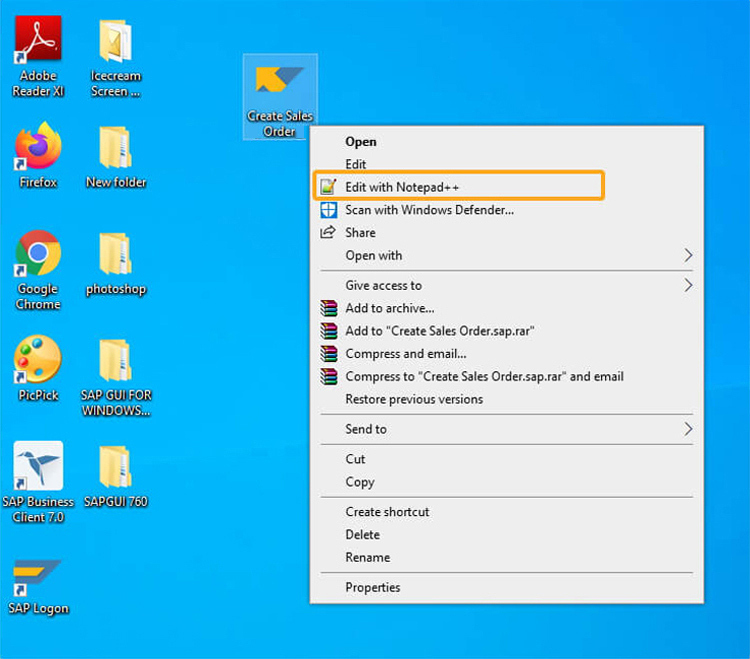
- In Notepad++, you can edit SAP connection details in the shortcut file to connect your Liquid UI for iOS App to the R/3 server, enabling access to your SAP server. You can also enhance security by adding SAP login credentials and SSO details. .sap files come in three types: type 1 includes SSO details, type 2 includes unencrypted SAP passwords and type 3 includes encrypted SAP passwords. Liquid UI for iOS supports all three types of SAP shortcut files.
// Create Sales Order.sap (Type 1: MYSAPSSO )
[System] Name=TR1 Client=800 GuiParm=/H/ZEUS.GUIXT.COM/S/3200 [User] Name=Sarvani at="MYSAPSSO2=AjExMDAgAAxwb3J0YWw6dW1hbsaeIABNiYXNpY2F1dGhlbnRpY2F0aW9uAQAFVU1BTkcCAAMwMDADAANOVzcEAAwyMDE5MDkxMTE5MTkFAAQAAAAICgAFVU1BTkf/AQUwggEBBgkqhkiG9w0BBwKggfMwgfACAQExCzAJBgUrDgMCGgUAMAsGCSqGSIb3DQEHATGB0DCBzQIBATAiMB0xDDAKBgNVBAMpjA05XNzENMAsGA1UECxMESjJFRQIBADAJBgUrDgMCGgUAoF0wGAYJKoZIhvcNAQkDMQsGCSqGSIb3DQEHATAcBgkqhkiG9w0BCQUxDxcNMTkwOTExMTkxOTA4WjAjBgkqhkiG9w0BCQQxFgQUeojOYAubG7V/PQADRbFBdKrfKHcwCQYHKoZIzjgEAwQvMC0CFQDAHylOAXrvYeiQADHqfDvhZHYJUQIUWxI4HYm5ZausUcnYCWlBfDQ1cMQ=" Language=EN [Function] Command=VA01 Type=Transaction [Configuration] Workplace=true
// Create Sales Order.sap (Type 2: SAP unencrypted password)[System] Name=TKR Description=Juneau Client=899 GuiParm=/H/ZEUS.GUIXT.COM/S/3200 [User] Name=Sarvani Password=LiquidUI Language=EN [Function] Title=Create Sales Order Initial Screen Command=VA01 [Configuration] WorkDir=C:\Users\Sarvani\Documents\SAP\SAP GUI [Options] Reuse=1
// Create Sales Order.sap (Type 3: SAP encrypted password)[System] Name=TKR Description=Juneau Client=899 GuiParm=/H/ZEUS.GUIXT.COM/S/3200 [User] Name=Sarvani Password= PW_14E8625D89A37557FC793D Language=EN [Function] Title=Create Sales Order Initial Screen Command=VA01
[Configuration] WorkDir=C:\Users\Sarvani\Documents\SAP\SAP GUI [Options] Reuse=1 - To use the SAP shortcut files on your iOS device, transfer the files from your Desktop to your Liquid UI for iOS devices using either a USB cable or WIFI.
- After transferring the SAP shortcut file to your iOS device, locate it in the Downloads folder. Clicking on the file TRX Create Sales Order.sap opens the Liquid UI for iOS app and automatically navigates to the specified SAP transaction.
